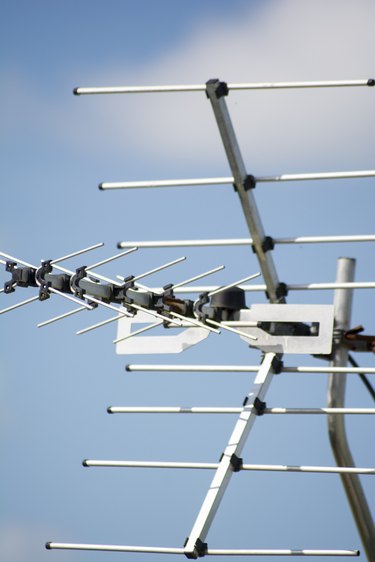
TV antenna signal strength is measured in NM(db), or noise margin in decibels, and Pwr(dBm), or power ratio in decibels-milliwatts. The first measurement tells you how "clean" the signal is, meaning how much residual static not associated with the actual program is included in the signal. The second measurement gives you the actual signal strength. NM(db) is important because a station could be right across the street from your antenna and be broadcasting with inferior or damaged equipment, and your reception would still be "snowy" and "flutter." Measuring these with the right equipment is relatively easy, but requires some skill.
Step 1
Disconnect the 75-ohm coaxialial cable running into your TV from the antenna mounted on your roof or from your indoor antenna.
Video of the Day
Step 2
Attach the "F" connector at the end of the 75-ohm coaxial to the input connector on your Pwr(dBm) measuring device.
Step 3
Turn on your Pwr(dBm) measuring device, and turn the tuner to the lowest numbered channel broadcasting in your area. If you have an antenna rotor or a directional indoor antenna, turn the antenna until the Pwr(dBm) meter reaches its highest level. Record the results.
Step 4
Use a compass to read the direction of the highest signal strength. Record the results.
Step 5
Proceed with the measuring of each succeeding channel, going up the scale until you reach the highest number. Record each result.
Step 6
Detach the 75-ohm coaxial "F" connector from the Pwr(dBm) measuring device, and then attach it to the input on your NM(db) measuring device.
Step 7
Proceed with the same measuring process used with the Pwr(dBm) device, recording each result in a column next to the previous measurement. Note any differences in compass readings.
Step 8
Use your compass readings to calculate an average for the optimal signal strength direction if you do not have a rotor-controlled antenna. If you are using a rotor, put a list of the optimal compass headings for each channel next to your rotor control box so you can turn your antenna in that direction when tuning in to that particular channel.
Video of the Day
- AntennaWeb: Maximize Your Television Reception
- Denny's TV Antenna Source: Better Digital TV Reception
- YouTube: How to Install Two HDTV Outdoor Antennas
- FCC: DTV Reception Maps
- TV Fool: Check Your Address for Free TV
- TabloTV: What Channels Can I Get?
- Sadoun Enterprises LLC: DigiairPro
- SolidSignal: Perfect Vision DIGIAIR PRO 2